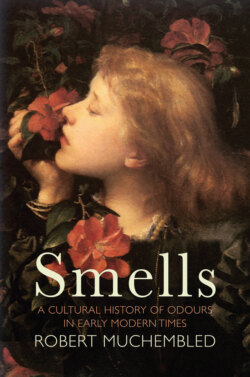Читать книгу Smells - Robert Muchembled - Страница 11
2 A pervasive stench
ОглавлениеThe good old days are a myth. The towns and villages of Europe stank terribly in days of yore. Since even the most dreadful smells were not necessarily as great a threat to health as the pollution that chokes us today, it is tempting to downplay the impact such foul stenches had on people’s lives. However, we should not overlook the fact that the noxious smells generated by a number of trades had the potential to harm the broader population. The dearth of research on this topic is not due to a lack of evidence, which is plentiful. Nor can it be attributed to our ancestors’ lack of sensitivity to such smells, as is often lazily suggested to dismiss the topic. We have long been coached into silencing our sense of smell, as required by a clean, orderly society, and we react against such disturbing olfactory phenomena. Only a few daring voices have dared touch on the unmentionable subject. ‘All smells are primordially the smell of shit’, one writes.1 This claim requires further substantiation: is the message received by an individual nose deemed good or bad? The answer really depends on the historical period. Nowadays it takes children a long while to learn to feel disgust for their own excrement. No such conditioning existed in the Renaissance. Yet in every culture, negative signals received by the brain are associated with death, warning the body of the risk of harm, while positive signals are associated with life and pleasure.
No human society is indifferent to smells. They are often thought of as tools mediating magical interactions. Various rites were thought to protect our ancestors against the foulest of smells, while sweet fragrances were used to earn the favour of the gods.2 Even before the advent of mains drainage, Europeans were perfectly aware of the terrible fug of smells that surrounded them. The Swedish scholar Carl Linnaeus proved a man of his time in 1756, when he drew up a subjective list of seven categories of natural smells, the majority of which were unpleasant: aromaticos (carnation and bay leaf), fragrantes (lily, saffron and jasmine), ambrosiacos (amber or animal musk), alliaceos (garlic and asafoetida, also known as Persian ferula), hircinos or ‘goat-like’ (goat, valerian), tetros or ‘foul’ (French marigold, some solanaceous plants) and nauseos (cucurbitaceous plants).3 Bad smells could now be labelled, but not eradicated: ways had to be found to deal with them, particularly in large urban areas where the air was thick with all sorts of stenches. As seen in chapter 1, we stop noticing even the most powerful smells after about fifteen minutes of exposure. However, such offensive odours were still a major risk to public health, as noted as early as 1700 by Bernardino Ramazzini, the father of occupational medicine.
